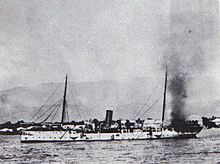Marcomannia incident
The Markomannia incident was a German-Haitian conflict in 1902 that was named after the Hamburg steamer Markomannia .
The incident
The Markomannia (3335 BRT, 1890) was a HAPAG steamer that was used in the liner service between the West Indies and Hamburg. On September 2, 1902, the steamer was stopped near the Haitian port city of Cap-Haïtien by the Haitian gunboat Crête-à-Pierrot and examined for contraband . The Crête à Pierrot belonged to a rebel faction under Anténor Firmin , which was in revolt against the provisional government of President Pierre Théoma Boisrond-Canal . The commander of the Crête à Pierrot was an English mercenary named Read, he was under the Haitian Admiral of Scottish descent Hammerton Killick (1856-1902). Read assumed that the Markomannia were transporting weapons and ammunition for government forces. The steamer was searched by a boarding party. Despite the protests of Captain Nansen and the German consul of Cap-Haïtien, the command confiscated weapons and ammunition and loaded them onto the Crête à Pierrot . The marcomannia was then able to continue its journey. Apart from the trip interruption, HAPAG suffered no material damage.
The battle between SMS Panther and the Crête à Pierrot
The German Prime Minister in the Haitian capital Port-au-Prince , Francsen, immediately requested a German warship, as German residents had already been harmed during the civil war. The imperial government gave in to this demand because the provisional government had already declared the Crête à Pierrot a pirate on July 25, 1902 , after Admiral Killick had declared himself for the rebellious side of Firmin. Killick had imposed a sea blockade on the Haitian waters , but this was not recognized by the USA due to its ineffectiveness. Nevertheless, in mid-August 1902, Killick had prevented the American steamer Paloma , which also carried weapons on board, from entering Cap-Haïtien.
On September 5, 1902, Corvette Captain Richard Eckermann (1862-1916), the commander of the German gunboat Panther , personally received the order from Francsen in Port-au-Prince to raise the crête à Pierrot . The Panther ran out immediately and went in search of the Haitian warship. The gunboat drove dimmed for war purposes. The very next day, September 6th, the Crête à Pierrot was discovered in the port of Gonaïves . Killick was not aware of the presence of German warships in the West Indies due to cut telegraph lines and he was therefore not prepared for a battle. Eckermann immediately asked Killick to hand it over. The withdrawal of the 150-man crew of the Crête à Pierrot was granted because Eckermann was unable to disarm, let alone accommodate them.
Killick apparently responded to Eckermann's demands and painted the flag. However, when a prize squad translated to the Crête à Pierrot , several explosions occurred on board. Eckermann decided to destroy the gunboat despite an intervention by the German consular agent von Gonaives, who feared anti-German excesses. The ship was taken under fire and sank to the bottom of the harbor basin. Killick had apparently been the only crew member left on board. His body was later recovered.
On board the Panther was also the naval officer and later writer and Free Corps Leader Bogislav von Selchow , who described the sinking of the Crête à Pierrot in 1936 in his memoir Hundred Days from My Life .
Consequences of the incident
Due to the excitement in the Haitian population, the panthers did not call at any northern Haitian ports for the time being. Apparently there were no riots against German residents, especially since Firmin was in principle very friendly to Germany. For the provisional government, which had no naval forces at its disposal, the intervention of the great power Germany was a welcome increase in its military capabilities, since arms could now be shipped by sea, including from abroad.
In 1943 a postage stamp with the portrait of Killicks was issued from Haiti. In the same year Charles Moravia published a play about him: L'amiral Killick: drame historique aux trois tableaus (Port-au-Prince 1943). In the Navy , the day of the sinking of the Crête was taken as a traditional event.
See also
literature
- o. V .: The destruction of the Haitian rebel cruiser "Crete à Pierrot" by SMKbt. "Panther" , in: Marine-Rundschau , 13th year, 1902, pp. 1189–1197.
- Fritz Otto Busch : Traditional Manual of the Navy . JF Lehmanns Verl., Munich / Berlin 1937, p. 114.
- Gerhard Wiechmann: The Prussian-German Navy in Latin America 1866-1914. A study of German gunboat policy . Hauschild, Bremen 2002, ISBN 3-89757-142-0 , pp. 72-80.
Web links
- Le navire "La Crete a Pierrot". Pikliz.com, February 28, 2006, accessed on October 31, 2010 (French, attention: Popups!): “Illustration of the Crete a Pierrot shortly before the sinking; Photo by SMS Panther on September 6, 1902 "
- The marcomannia at Miramar Ships Index
- Note in the New York Times of September 26, 1943 about the introduction of Haitian postage stamps depicting Hammerton Killick

